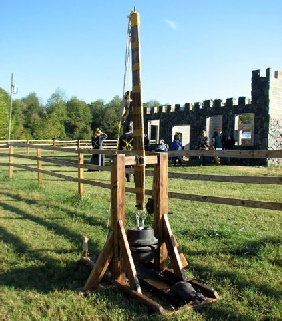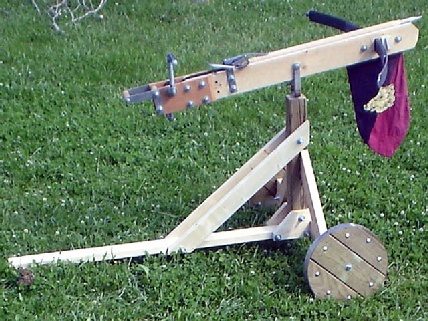

What had started out as a minor curiosity for me has turned to my primary focus with in the society. When I first began playing, I grabbed on to armoring with both hands, my teeth and toes. This was my calling, or at least that’s what I thought until a stumbled onto a program on PBS. I was clicking through the mindless dribble that passes for entertainment on the television when a coming up next commercial caught my eye. Nova's 'Secrets of Lost Empires; Medieval Siege' sparked within me an interest in siege weapons. Two teams of men were each building a form of medieval artillery called a trebuchet. Being a mechanical engineer by profession I though “I have make one of those… “ And so began the research and construction of my first trebuchet.

1/12 Scale Trebuchet (27” wide x 36” long x 38” high at rest, 19-1/2” high cocked)
Prior to the completion of this engine, several .mpg files were made to aid the further study and documentation of the weapon's dynamics while firing. The clips available from this page were taken while at the time I was still experimenting with golf balls as my chosen projectile. Incidentally, this was also before the windlass mechanism was completed.
To view the files choose from the titles below: (Windows Media Player tends to display these files best. Quicktime has been known to black out their image.)
My aspirations for my third scale trebuchet have warped and cracked... literally. I was originally halted by a lack of prime lumber, then later by a lack of square corner 4” x 4”; x 8' lumber. I turned to other projects and have from time to time looked for good lumber. Unfortunately during the delay the timbers warped, cracked and split to a point I did not feel the engine was safe to use. It has since been dismantled and cannibalized for other projects.
I had started to research springaulds and Chinese ballistae to decide which I will make next, but ended up starting a (roughly) half scale barrel counterweight trebuchet followed by a 1/12 scale Lu'ab or Arabic, traction beam-sling (seen further down this page). The barrel counterweight trebuchet made it’s début at War of the Wings II with very little pride on my part. While the engine looks pretty good, it's function was lacking. It was more of an engine selection issue then design, but either way I was not happy. It needs wheels!! Transporting the assembled engine with 300# of ballast was not easy/fun. The prong was also an issue. It was not adjustable for range. That was a bad design! Regardless it has not seen the light of day as I since as I've not had the time or ambition to correct any of these problems. Here she is Castle Elkinburg with Aegratatio (the crew's mascot)…

"Mortis Plaga" (4'-4" wide x 6'-1" long x 8'-6 5/8" high at rest, 5'-0 1/2" high cocked)
Since my lady has begun to show an interest in authorizing in siege, I decided to postpone my springauld and whip up an engine a little simpler for her to use... an arbalest. What you will see below my interpretation of the Docmo Kincain arbalest. There are several modifications and configurations incorporated weapon starting most noticeably with the windlass. The walls has been shrunk and streamlined as has the crank. I have 1/4" thick steal plates with a wench fabricated on the same bolt pattern since winding the weapon gets a bit difficult for my 5' tall lady near the latching point. I'm not sure if I will end up using it since 1) she is determined to wind the thing as is and 2) the wench is a bit slower then the windlass. I think it will come down to how I "finish" the plates for rust prevention. I do not like "paint", so I either need to heat & oil quench the plates to form a protective scale coating, or "blue" them. While a film of oil is period, it's too messy to consider.
Another addition you will also note is a secondary set of holes for the nut loop behind the first. The assembly can be slid back about 4" to increase range without having to unstring the prod. It's a much faster and easier way to change range setting between battles. I'm not sure how it's going to play out at authorization, but worst case, the nut loop stays put for the day.
The other differences are pretty minor. The handle was made easier to hold and use as a brace. I find a 1 1/4" dowel much more comfortable the original flat bar design. It's also more armor and/or stomach friendly when you are winding. The carriage is a simple rolling tripod. There is nothing special about it other then I chose to cope the vertical post for looks. Structurally it has no bearing. The picture below is not up to date, but it's better then nothing and will serve to show some of the differences I incorporated provided you are familiar with the Docmo weapon.

"Virga Conicio" (4'-9 1/2" wide x 4'-11 1/4" long cross on a 4'-1 1/4" wide by 5'-9" long tripod, 3'-9 1/2" high leveled)
Undertaking the research for the trebuchet described on this page not only enlightened me as to the numerous types of trebuchet and catapult, but it brought me in contact with several other engines of warfare and siege. I began to collect period documentation on drills (used to topple castle walls), gonne, cannon and sea (Greek) fire. The latter rapidly brought me in contact with niter (black) powder and subsequently it’s research. This then lead to bombs, grenades and other flame throwing hand siphons. My research in the machines of warfare began to consume the majority of my “free” time, becoming my new and true focus in the society. That fire within has lead me to, as I understand it, the first Atlantian Siege Laurel and the second in the country. Each day my knowledge increases as I seek both to learn from and educate others in this art.
As my research files began to become unwieldy, I found it increasingly difficult to decide what engine to build next and therefore just kept researching. I have since decided to pursue the less well-known engines in order to get more of my knowledge out into the public. Consequently, the next engine on my drawing board will be a springauld. This device can be described as a “ballista in a box”; however, this does not do the machine justice. It is better described as an engineer having taken the twisted skein and prod design from Roman catapults and building them into a wooden frame-work box. One version of these engines may be seen at the bottom of folio 201r of Romance of Alexander, 1338-44.
Since the posting of this web page, I have had numerous requests for teaching classes on trebuchets. In response to them, I have sought out a simple design available to anyone interested, as well as beginning work on a syllabus for such a class. The existing design I found most “novice-friendly”, comes from the December 1997 issue of American Woodworker magazine. It is an article titled “Trebuchet!” by Russell Miners, running from page 62 to 66. I chose to make the class kits at 2/3rds of the original plan’s scale to size them to a standard marshmallow. The students will learn some history and principles of design before assembling the kits. They will then have a “hands on” education regarding the relationship of the ballast weight, projectile size and sling length as they pick a projectile and try to maximize their engine’s range by adjusting weight and sling length. When they complete this task, a second projectile of differing weight/size will be given them to demonstrate this relationship and the importance of consistency in projectile parameters.
Below (left) is a picture of an assembled prototype of one of the kits. While this unit uses steel axles, the class kits will not. Otherwise, the results are as you see it.
Simply because another one of my side hobbies is trying to micronize things, I decided to try a 1/3 scale version of Miners’ plans (below right). It came out pretty well with the exception that it is difficult to cock. Incidentally, it is sized perfectly for mini-marshmallows.
|
|
|
|
|
|
Siege drills have been used nearly as long as there have been brick walls to use them against. The device, in simplest terms, is an oversized bow-drill. A crew of two to four (2-4) men would carry the drill to a castle wall, where 1-2 would position the drill angled upwards against the wall while the others slid a greased cap over the tail end and wedged the drill into place. The drill would then be rotated back and forth by 1-2 men while the others kept pressure on the drill forcing it to bore deeper into the wall. The borer shown above uses a bow to reciprocate the blade, and is held in place by men, however, some were mounted in frames and worked by rods radiating out like spokes from their borer, and still others were worked as a medieval pole lathe.
The debris fell from the deepening hole due to gravity. When the hole was deemed sufficient, the drill would be removed, wood and dried grass would be placed in the holes and light. The fires were maintained until the wall was superheated, at which time a battering ram was brought forth and used to strike the wall among the burning holes and shatter the bricks causing the wall to collapse. Occasionally, the ram was not needed as the air entrained in the bricks during manufacture would expand enough to explode the brick on it’s own, similar to a stoke exploding in a camp fire.
Copyright Terms, Copyright Wolfram von Taus © 2007